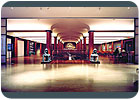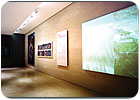
The 70,000-square-foot Rubin Museum of Art (RMA) in Manhattan features two varieties of French limestone from Francepierre International S.N.C., including honed Corton limestone, which was used for flooring throughout the main lobby level.
The 70,000-square-foot Rubin Museum of Art (RMA) occupies what was formerly a portion of the Barneys department store in Manhattan's Chelsea neighborhood. According to The American Institute of Architects, the architectural center of the RMA is a 6-story spiral stone staircase designed by Andree Putman, which served as inspiration to convert the building from a department store to a museum. The renovation included the use of French limestone to create a contemplative environment for the display of the largest collection of Himalayan art in the Western world.

Honed Corton limestone was utilized in 10- x 30-inch pieces for the floor.
Honed Corton limestone was selected for the flooring throughout the main lobby level, while flamed Hautville limestone was used for the feature wall in the main lobby. The materials were supplied by Francepierre International S.N.C. of Les Ulis Cedex, France.

“The choice of stone aided in overcoming the challenge of creating a transition from the frenetic New York City streets to a quiet, almost meditative atmosphere in which to view the collection,†said Stanley Wong, Associate Partner of Beyer Blinder Belle of New York, NY.
The flooring throughout the main lobby features pieces of Corton limestone with a standard dimension of approximately 10 x 30 inches. Tim Culbert of Atelier Imrey Culbert created a thematic, abstract pattern of the Mandala in the gallery floors and ceilings, and the shape is also subtly reflected in the stone flooring pattern.

“The lobby contains the most significant stone installations,†said Wong. “The feature stone wall contains a hidden support system for sculpture. Open vertical joints at key spots allow for removable armatures to handle the heavy loads of sculpture. The armatures can then have brackets customized for a specific sculpture, graphic, or any other form of display.â€
Wong said the biggest challenge was that the existing stairs, structure and elevators prohibited a mud bed installation. The crew overcame this obstacle by utilizing an uncoupling membrane (Schlüter Ditra) to help mitigate slab movement and aid in the level of the stone installation.

Flamed Hautville limestone was used for the feature wall in the main lobby.
According to representatives from the RMA, the goal of the museum is to provide an environment and tools for people to find their own connections with the artwork, and to make them part of their visual vocabulary, their resource of delight and their refined awareness of the world.
Construction of the museum began in Fall 2002 and doors opened to the public on October 29, 2004. “The Rubin Museum of Art is a success, and is the vibrant educational and cultural center that it was intended to be,†said Wong.
Rubin Museum of Art: New York, NY
Architect:Beyer Blinder Belle, New York, NYAssociate Architects:Atelier Imrey Culbert, New York, NY
Stone Supplier:Francepierre International S.N.C., Les Ulis Cedex, France
Stone Installer:Port Morris Tile & Marble, Bronx, NY